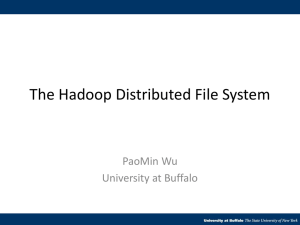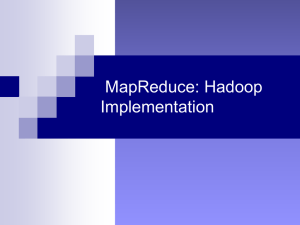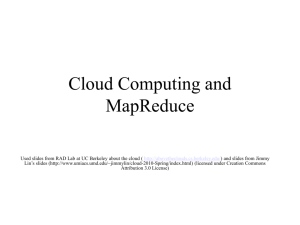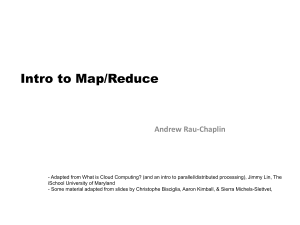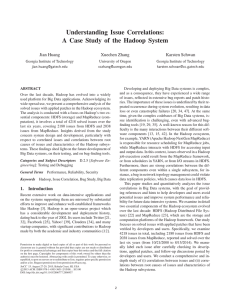ppt
advertisement
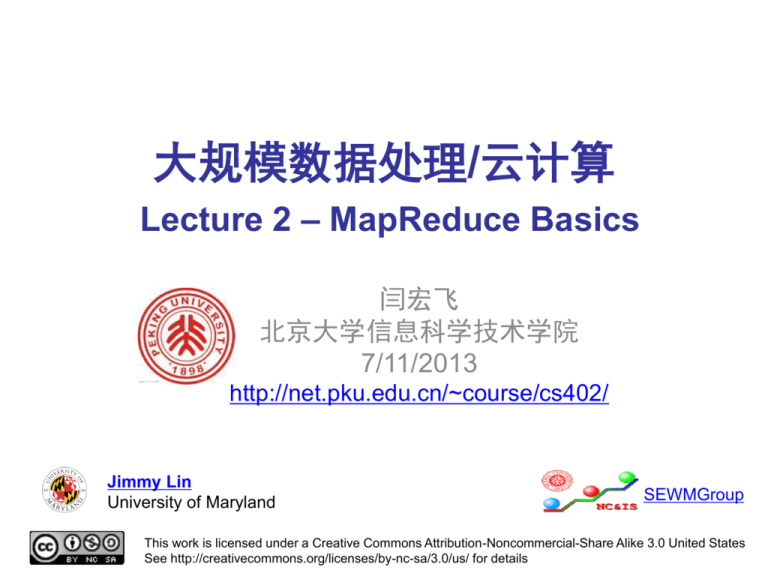
大规模数据处理/云计算 Lecture 2 – MapReduce Basics 闫宏飞 北京大学信息科学技术学院 7/11/2013 http://net.pku.edu.cn/~course/cs402/ Jimmy Lin University of Maryland SEWMGroup This work is licensed under a Creative Commons Attribution-Noncommercial-Share Alike 3.0 United States See http://creativecommons.org/licenses/by-nc-sa/3.0/us/ for details Contents 1 Introduction 2 MapReduce Basics 3 Basic MapReduce Algorithm Design 4 Inverted Indexing for Tex Retrieval 5 Graph Algorithms 6 EM Algorithms for Text Processing Chapter 2 MapReduce Basics 2.1 Functional Programming Roots 2.2 Mappers and Reducers 2.3 The Execution Framework 2.4 Partitioners and Combiners 2.5 The Distributed File System 2.6 Hadoop Cluster Architecture MapReduce HDFS 3 How do we scale up? Source: Wikipedia (IBM Roadrunner) Divide and Conquer “Work” Partition w1 w2 w3 “worker” “worker” “worker” r1 r2 r3 “Result” Combine Parallelization Challenges • • • • • • How do we assign work units to workers? What if we have more work units than workers? What if workers need to share partial results? How do we aggregate partial results? How do we know all the workers have finished? What if workers die? What is the common theme of all of these problems? Common Theme? • Parallelization problems arise from: – Communication between workers (e.g., to exchange state) – Access to shared resources (e.g., data) • Thus, we need a synchronization mechanism Source: Ricardo Guimarães Herrmann Managing Multiple Workers • Difficult because – We don’t know the order in which workers run – We don’t know when workers interrupt each other – We don’t know the order in which workers access shared data • Thus, we need: – Semaphores (lock, unlock) – Conditional variables (wait, notify, broadcast) – Barriers • Still, lots of problems: – Deadlock, livelock, race conditions... – Dining philosophers, sleepy barbers, cigarette smokers... • Moral of the story: be careful! Current Tools Shared Memory Memory • Programming models Message Passing – Shared memory (pthreads) – Message passing (MPI) • Design Patterns P1 P2 P3 P4 P5 – Master-slaves – Producer-consumer flows – Shared work queues P1 P2 P3 P4 P5 producer consumer master work queue slaves producer consumer Where the rubber meets the road • Concurrency is difficult to reason about • Concurrency is even more difficult to reason about – At the scale of datacenters (even across datacenters) – In the presence of failures – In terms of multiple interacting services • Not to mention debugging… • The reality: – Lots of one-off solutions, custom code – Write you own dedicated library, then program with it – Burden on the programmer to explicitly manage everything Source: Wikipedia (Flat Tire) Source: MIT Open Courseware Source: MIT Open Courseware Source: Harper’s (Feb, 2008) What’s the point? • It’s all about the right level of abstraction – The von Neumann architecture has served us well, but is no longer appropriate for the multi-core/cluster environment • Hide system-level details from the developers – No more race conditions, lock contention, etc. • Separating the what from how – Developer specifies the computation that needs to be performed – Execution framework (“runtime”) handles actual execution The datacenter is the computer! “Big Ideas” • Scale “out”, not “up” – Limits of SMP and large shared-memory machines • Move processing to the data – Cluster have limited bandwidth • Process data sequentially, avoid random access – Seeks are expensive, disk throughput is reasonable • Seamless scalability – From The Mythical Man-Month to the tradable machine-hour MapReduce Roots in Functional Programming Map f f f f f Fold g g g g g Typical Large-Data Problem Iterate over a large number of records Extract something of interest from each Shuffle and sort intermediate results Aggregate intermediate results Generate final output Key idea: provide a functional abstraction for these two operations 21 (Dean and Ghemawat, OSDI 2004) 2 MapReduce Basics 2.1 Functional Programming Roots 2.2 Mappers and Reducers 2.3 The Execution Framework 2.4 Partitioners and Combiners 2.5 The Distributed File System 2.6 Hadoop Cluster Architecture 22 MapReduce Programmers specify two functions: map (k1, v1) → [(k2, v2)] reduce (k2, [v2]) → [(k3, v3)] All values with the same key are sent to the same reducer The execution framework handles everything else… 23 k1 v1 k2 v2 map a 1 k3 v3 k4 v4 map b 2 c 3 k5 v5 k6 v6 map c 6 a 5 map c 2 b 7 c 8 Shuffle and Sort: aggregate values by keys a 1 5 b 2 7 c 2 3 6 8 reduce reduce reduce r1 s1 r2 s2 r3 s3 24 MapReduce Programmers specify two functions: map (k1, v1) → [(k2, v2)] reduce (k2, [v2]) → [(k3, v3)] All values with the same key are sent to the same reducer The execution framework handles everything else… What’s “everything else”? 25 MapReduce “Runtime” Handles scheduling Handles “data distribution” Gathers, sorts, and shuffles intermediate data Handles errors and faults Moves processes to data Handles synchronization Assigns workers to map and reduce tasks Detects worker failures and restarts Everything happens on top of a distributed FS (later) 26 MapReduce Programmers specify two functions: map (k1, v1) → [(k2, v2)] reduce (k2, [v2]) → [(k3, v3)] All values with the same key are reduced together The execution framework handles everything else… Not quite…usually, programmers also specify: partition (k2, number of partitions) → partition for k2 Often a simple hash of the key, e.g., hash(k2) mod n Divides up key space for parallel reduce operations combine [(k2, v2)] → (k2, [v2]) Mini-reducers that run in memory after the map phase Used as an optimization to reduce network traffic 27 k1 v1 k2 v2 map a 1 k4 v4 map b 2 c 3 combine a 1 k3 v3 c 6 a 5 map c 2 b 7 combine c 9 partition k6 v6 map combine b 2 k5 v5 a 5 partition c 8 combine c 2 b 7 partition c 8 partition Shuffle and Sort: aggregate values by keys a 1 5 b 2 7 c 2 3 9 6 8 8 reduce reduce reduce r1 s1 r2 s2 r3 s3 28 Two more details… Barrier between map and reduce phases But we can begin copying intermediate data earlier Keys arrive at each reducer in sorted order No enforced ordering across reducers 29 “Hello World”: Word Count 30 MapReduce can refer to… The programming model The execution framework (aka “runtime”) The specific implementation Usage is usually clear from context! 31 MapReduce Implementations Google has a proprietary implementation in C++ Hadoop is an open-source implementation in Java Bindings in Java, Python An Apache project Large contribution of development led by Yahoo, used in production Rapidly expanding software ecosystem Lots of custom research implementations For GPUs, cell processors, etc. 32 User Program (1) submit Master (2) schedule map (2) schedule reduce worker split 0 split 1 split 2 split 3 (5) remote read (3) read worker worker (6) write output file 0 (4) local write split 4 worker output file 1 worker Input files Map phase Intermediate files (on local disk) Reduce phase Output files 33 Adapted from (Dean and Ghemawat, OSDI 2004) Hadoop Distributed File System How do we get data to the workers? NAS SAN Compute Nodes What’s the problem here? 35 Distributed File System Don’t move data to workers… move workers to the data! Why? Store data on the local disks of nodes in the cluster Start up the workers on the node that has the data local Not enough RAM to hold all the data in memory Disk access is slow, but disk throughput is reasonable A distributed file system is the answer GFS (Google File System) for Google’s MapReduce HDFS (Hadoop Distributed File System) for Hadoop 36 GFS: Assumptions Commodity hardware over “exotic” hardware High component failure rates Multi-gigabyte files are common, if not encouraged Files are write-once, mostly appended to Inexpensive commodity components fail all the time “Modest” number of huge files Scale “out”, not “up” Perhaps concurrently Large streaming reads over random access High sustained throughput over low latency 37 GFS slides adapted from material by (Ghemawat et al., SOSP 2003) GFS: Design Decisions Files stored as chunks Reliability through replication Simple centralized management No data caching Each chunk replicated across 3+ chunkservers Single master to coordinate access, keep metadata Fixed size (64MB) Little benefit due to large datasets, streaming reads Simplify the API Push some of the issues onto the client (e.g., data layout) HDFS = GFS clone (same basic ideas) 38 From GFS to HDFS Terminology differences: GFS master = Hadoop namenode GFS chunkservers = Hadoop datanodes Functional differences: No file appends in HDFS (planned feature) HDFS performance is (likely) slower For the most part, we’ll use the Hadoop terminology… 39 HDFS Architecture HDFS namenode Application (file name, block id) HDFS Client /foo/bar File namespace block 3df2 (block id, block location) instructions to datanode (block id, byte range) block data datanode state HDFS datanode HDFS datanode Linux file system Linux file system … … 40 Adapted from (Ghemawat et al., SOSP 2003) Namenode Responsibilities Managing the file system namespace: Coordinating file operations: Holds file/directory structure, metadata, file-to-block mapping, access permissions, etc. Directs clients to datanodes for reads and writes No data is moved through the namenode Maintaining overall health: Periodic communication with the datanodes Block re-replication and rebalancing Garbage collection 41 Putting everything together… namenode job submission node namenode daemon jobtracker tasktracker tasktracker tasktracker datanode daemon datanode daemon datanode daemon Linux file system Linux file system Linux file system … slave node … slave node … slave node 42 References [Lin]Ch2:Mapreduce Basic [Tom]Ch6:How mapreduce works 2003 "The Google file system," in sosp. Bolton Landing, NY, USA: ACM Press, 2003. 2004 "MapReduce: Simplified Data Processing on Large Clusters," in osdi, 2004, 43

